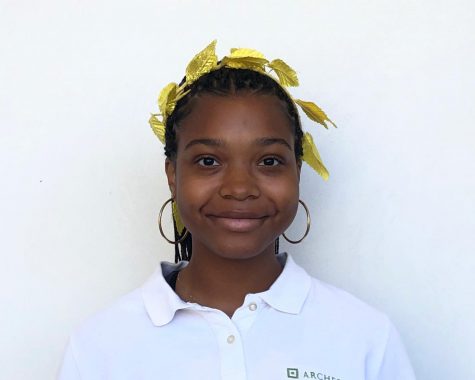Review: ‘PEN15’ transports viewers back to their embarrassing middle school years
Photo credit: Hulu Promotional Images
Maya Erskine and Anna Konkle pose as their characters in their Hulu original series “PEN15.” The show follows Erskine and Konkle as they depict fictionalize versions of their middle school selves.
March 2, 2022
Disclaimer: “PEN15” is a Hulu original series that may be inappropriate for younger audiences. The show features explicit language, underage drinking and sexual scenes. The Oracle does not recommend this series for our younger readers, and Common Sense Media estimates it is appropriate for ages 15+.
Comedians Maya Erskine and Anna Konkle perfectly capture the painfully embarrassing middle school experience in their cringe-comedy “PEN15.” The Hulu original series follows Erskine and Konkle as they act as fictionalized versions of their sixth grade selves in the year 2000.
The show grapples with serious topics, such as family trauma, self-image and race. Konkle’s character, Anna Kone, is often thrown into the middle of her parents’ disruptive marriage, having to be the mediator on numerous occasions. Kone’s mother (Melora Walters), is emotionally unavailable at times, which causes her to grow closer to her father (Taylor Nichols).
Erskine’s character, Maya Ishii-Peters, is biracial and identifies as both Japanese and white. She struggles to embrace her Asian identity and culture while attending a school that is primarily white. Ishii-Peters lives with her mother (Mutsuko Erskine), who happens to be Erskine’s biological mother, and her father (Richard Karn).
Through cringe-inducing plotlines and scenes, Erskine and Konkle’s characters deal with first crushes, romance and relationships. When Anna begins dating her first boyfriend Brendan (Brady Allen), she struggles with nerves and feels embarrassed when both receiving and giving affection in school. Anna tries to include Maya in her relationship, and throughout the series, the girls work to find Maya a boyfriend.
Despite Erskine and Konkle being adults, the middle schoolers around them are played by actual children. Although this unique casting decision caused several moments of extreme secondhand embarrassment, I enjoyed every minute of it. Erskine and Konkle did a brilliant job bringing these fictionalized versions of their younger selves to life, and with every episode and storyline, I started to believe they truly were middle schoolers.
The series transports viewers into the early 2000s with unique costumes. Erskine and Konkle’s characters’ wardrobes are trendy, stylish and adorably dorky at times, all the while staying true to the era. Anna is seen rocking a floor-length cargo-pocket skirt on numerous occasions, and as much as I loved her outfits, I couldn’t quite bring myself to like that statement piece.
Although I enjoyed Erskine and Konkle’s characters, I found them both unbelievably aggravating at times. I recall screaming at the television screen on numerous occasions, begging them to make better decisions when it came to love interests, friends and social gatherings.
The program is rated MA and features explicit sexual scenes. Despite its rating, the show does a surprisingly meaningful job delving into serious situations such as Erskine’s character’s relatable battle with self-esteem. After an embarrassing rejection from a crush, where he insults her appearance and personality, Ishii-Peters retreats to her room for an extended period of time. She looks in the mirror while repeatedly announcing that she wishes she was pretty.
A side character I found quite enjoyable was Maya’s older half-brother, Shuji Ishii-Peters (Dallas Liu). He made sparse appearances throughout the show, and whenever he was on screen, he was either annoying his sister and her best friend or poking fun at the girls’ ridiculous antics and attempts to gain popularity.
Despite his nonchalant and sometimes irritating attitude, Shuji was always there for his sister whenever she needed his support, like the time when Anna made an awful attempt to educate her classmates about racism, and the experiment resulted in Maya feeling humiliated and insulted.
Another notable character is Maya’s mother, Yuki Ishii-Peters. While researching this show, I discovered Yuki was played by Erskine’s actual mother, Mutsuko Erskine. In spite of this being Mutsuko’s first acting gig, her performance was believable and entertaining. In a special episode titled “Yuki,” viewers were given an inside look into an almost average day for the hard-working wife and mother of two.
One critique I have, if any, is the show coming to an end. Both Erskine and Konkle made the decision to end the series to start their separate families, so viewers only saw Maya and Anna as sixth graders. I would have loved it if the series followed them throughout their entire middle school experience, and came to an end when the girls went off to high school. This way, viewers would have had a real chance to see these characters mature and develop.
Overall, I thoroughly enjoyed this series and have rewatched it numerous times. The show is perfect to watch when you don’t want to sit through something too heavy. I found some of the stylistic choices with editing and production hilarious, and I appreciated the painful authenticity when portraying the middle school experience. I highly recommend this show to those who enjoy an out-of-the-box comedy.
-
Story
-
Acting
-
Technical Quality
-
Enjoyment
-
Impact
Summary
The Hulu original “PEN15” follows creators Maya Erskine and Anna Konkle as they act as fictionalized versions of their middle school selves. The series is set in the year 2000, and viewers are transported to the time period through the characters’ trendy outfits and the use of outdated slang. Despite both Erskine and Konkle being adults, the middle schoolers around them are portrayed by actual children. This is a ridiculous and awkward casting decision that will keep viewers transfixed. Through hilarious plotlines and scenes, the show grapples with serious issues such as familial trauma, self-image and race.









